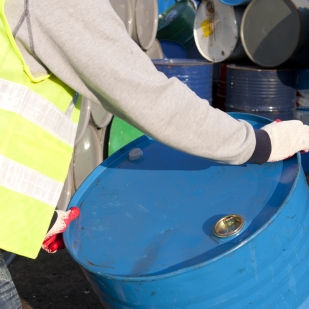06.B Hazardous or Toxic Agents Handling.
06. B.01
Chemical Hazard Communication (HazCom). A written HazCom Program must be developed when hazardous or toxic agents (any chemical which is a physical/health hazard) are present or procured, stored or used at a project site (per 29 CFR 1910.1200). The written HazCom program must address the following in project- specific detail:
- Hazardous or Toxic Agent Inventory. A list of the hazardous or toxic agents with the following information:
- (1) Explanation of how the agents are to be used at the project.
- (2) For emergency response purposes, approximate quantities (e.g., liters, kilograms, gallons, pounds) that are onsite or will be on site at any given time must be provided for each material. If the chemical name and/or quantity and/or location are classified information, it must be maintained in a location so that it can be provided to emergency responders during an emergency. This could be in a secure area outside of the area the chemical is used or stored, or just outside the entrance to the location in a secure box.
- (3) A site map will be attached to the inventory showing where inventoried substances are stored.
- (4) The inventory and site map will be updated annually at a minimum, but as frequently as necessary to ensure it is current and accurately reflects those materials on site.
- Hazardous or Toxic Agent Labeling. Procedures for assuring that containers used to store and transport hazardous or toxic agents around the project site are appropriately labeled to communicate the physical and health hazards associated with the agents in the containers. The pictorial labels required by the OSHA HazCom standard are acceptable labels.
- Material Safety Data Sheet (MSDS) or Safety Data Sheet (SDS) Management. Procedures to ensure MSDSs (SDSs) are maintained at project site for each chemical, combustible dust, or product. During the period of 2013 through 2016, the MSDS will be phased out and replaced with the SDS. The new SDSs content is mandated and allows for the toxicological hazard to be based on similar chemicals. For the purpose of this manual, either a MSDS or SDS meeting the criteria of the OSHA globally harmonized system standard (GHS) is acceptable.
- (1) Employees must have access to the MSDSs (SDSs) and the safety and health protection procedures.
- (2) Applicable information contained in the MSDS (SDS) must be incorporated in the AHA/PHAs. If the chemical or toxic agent is used extensively in the operation, the applicable information must be incorporated into the AHA and MSDS (SDS) must be attached to the AHA.
- (3) The information will be followed in the use, storage, and disposal of material and selection of hazard control and emergency response measures.
- Employee Information and Training. Procedures to ensure employees are trained initially and periodically when use of hazardous or toxic agents is altered or modified to accommodate changing on-site work procedures. Training must be provided to employees working with or in the area of use of any potentially hazardous chemical. Training must cover the following topics:
- (1) Requirements of the HazCom program on the project;
- (2) The location of all hazardous or toxic agents at the project;
- (3) Identification and recognition of hazardous or toxic agents on the project;
- (4) Physical and health hazards of the hazardous or toxic agents pertinent to project activities;
- (5) Protective measures employees can implement when working with project-specific hazardous or toxic agents.
- (6) The location and content of the MSDS (SDS) for the chemicals. The content and meaning of the information provided on the MSDS.
- (7) All workers in locations covered by the HazCom standard must be briefed on the recent changes to the standard. These changes include MSDS to SDS, label content, the new pictographs on the labels, and an explanation of chemical banding.
Knowledge Check Choose the best answer for the question.
6-3. What is required if a chemical or toxic agent is used extensively in the operation?
You forgot to answer the question!

